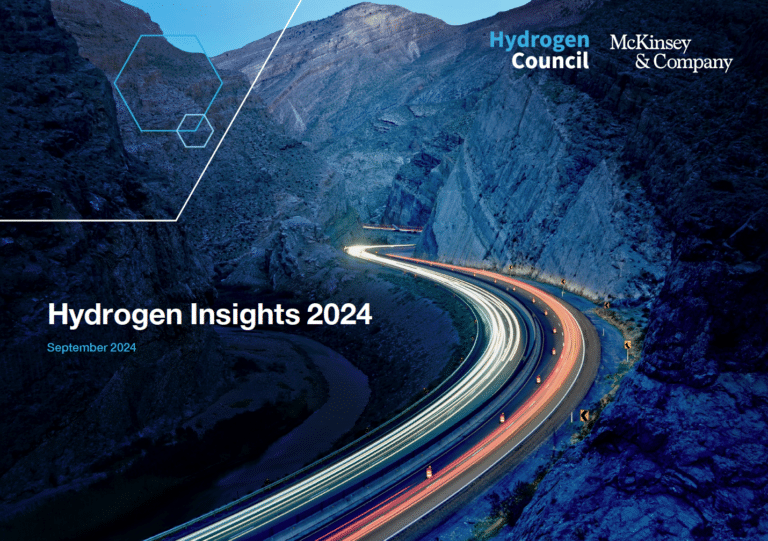Introduction: The Rise of Clean Hydrogen
The hydrogen economy is gaining momentum as a crucial player in the global transition to sustainable energy. The Hydrogen Council’s latest report, co-authored with McKinsey & Company, reveals an impressive growth trajectory in the clean hydrogen project pipeline. As of May 2024, the number of hydrogen projects worldwide has surged from 228 in 2020 to 1,572, reflecting a seven-fold increase. Despite this promising growth, the report underscores the urgent need for accelerated deployment to meet global climate goals. This article delves into the findings of the Hydrogen Insights 2024 report, examining the current state of clean hydrogen projects, investment trends, challenges faced by the sector, and the collective effort needed to achieve a hydrogen-powered future.
The Expanding Hydrogen Project Pipeline
A Surge in Projects and Investment
The Hydrogen Insights 2024 report highlights the significant expansion of the clean hydrogen project pipeline. The number of projects reaching Final Investment Decision (FID) has notably increased, from 102 projects with approximately USD 10 billion in investment in 2020 to 434 projects totaling around USD 75 billion in 2024. This shift signifies a maturation in the hydrogen sector, moving from mere planning to actionable commitments.
Furthermore, the report indicates a 20% increase in total announced investments through 2030, climbing from USD 570 billion to USD 680 billion. This trend is predominantly observed in more advanced stages of project development, where investments past FID surged by 90%, while front-end engineering design (FEED) projects grew by 30%. These figures reflect a robust commitment to advancing clean hydrogen technologies and projects toward execution.

Strategic Focus on Implementation
The transition from project announcements to implementation is evident in the analysis of the project pipeline. The natural attrition process within the hydrogen sector, similar to trends seen in wind and solar energy development, is fostering a more mature industry. By eliminating less viable projects, the sector is prioritizing those with the highest potential for success. This strategic focus on actionable projects not only signals investor confidence but also contributes to the overall health and sustainability of the hydrogen economy.
Jaehoon Chang, President and CEO of Hyundai Motor Company, emphasized this point, stating, “The seven-fold increase in committed capital for hydrogen projects reaching FID over the past four years demonstrates the industry’s progress. We are pleased to see the industry walking the talk at this critical transitional moment.”
Investment Trends and Future Projections
Commitment to Long-term Growth
The dramatic rise in committed investments is a positive indication of the sector’s long-term growth potential. The Hydrogen Insights report illustrates that the clean hydrogen market is evolving rapidly, with substantial financial backing for projects. This shift not only enhances the feasibility of existing projects but also stimulates innovation and development in hydrogen technology.
As highlighted by Ivana Jemelkova, CEO of the Hydrogen Council, “This report sends a clear message: hydrogen is happening. Now that hydrogen is a reality in the energy transition, it’s time to drive significantly more investment by 2030 to meet our mid-century targets.” The call for increased investment is critical, as the sector must address both current challenges and future demands to support widespread hydrogen adoption.
The Impact of Macroeconomic Factors
Despite the promising growth trajectory, the hydrogen sector faces several macroeconomic headwinds, including rising inflation and interest rates. These factors can complicate funding opportunities and delay project timelines. Furthermore, geopolitical tensions are influencing energy markets, creating uncertainties that could affect investor sentiment.
Sector-specific challenges, such as regulatory uncertainty and rising costs for renewable energy and electrolysers, are also contributing to project delays, particularly in renewable hydrogen initiatives. Navigating these challenges will require a concerted effort from industry stakeholders to foster a conducive investment environment.
Addressing Challenges in the Hydrogen Sector
Regulatory Framework and Support
For the hydrogen sector to realize its full potential, a supportive regulatory framework is essential. Sanjiv Lamba, CEO of Linde and Co-Chair of the Hydrogen Council, stated, “Realising hydrogen’s full climate and socio-economic potential requires a united effort from governments and industry. With a supportive regulatory framework and targeted incentives, investors will have the certainty they need to move projects to FID.”
Governments play a critical role in shaping policies that encourage investment in hydrogen technologies. Implementing clear and stable regulatory frameworks can help mitigate uncertainty and foster investor confidence. Additionally, targeted incentives, such as tax credits and grants, can provide the necessary support for project developers to move forward with their initiatives.
Collaboration Across Sectors
Collaboration among various stakeholders is crucial for overcoming the challenges faced by the hydrogen sector. The Hydrogen Council, representing a diverse group of 140 companies across the global hydrogen value chain, emphasizes the importance of cooperation between industry, governments, investors, and civil society. By promoting dialogue and sharing best practices, stakeholders can identify and address common challenges, ultimately facilitating the deployment of hydrogen ecosystems worldwide.
The Council’s commitment to promoting collaboration aligns with its goal of unlocking the sustainability potential of clean hydrogen. By fostering innovation and creating a supportive environment for development, stakeholders can contribute to a more resilient and robust hydrogen economy.
Climate Insider Analysis: The Future of Clean Hydrogen
As the hydrogen sector continues to evolve, it’s essential to consider the broader implications of its growth within the context of the global climate agenda. The rise in clean hydrogen projects represents not just an opportunity for investment and technological innovation but also a crucial pathway to achieving net-zero emissions targets set by various nations and corporations worldwide.
The Role of Clean Hydrogen in Decarbonization
Clean hydrogen has the potential to play a transformative role in decarbonizing sectors that are traditionally hard to electrify, such as heavy industry and transportation. By providing a versatile energy source, hydrogen can facilitate the transition away from fossil fuels in applications ranging from steel production to long-haul trucking. This versatility underscores hydrogen’s significance as a cornerstone of future energy systems.
However, realizing this potential necessitates a concerted effort to enhance production methods, improve infrastructure, and create a cohesive market for hydrogen. The industry’s ability to scale effectively will depend on developing a robust ecosystem that includes production, storage, distribution, and consumption technologies. As stakeholders invest in these areas, the synergy between hydrogen and other renewable technologies can amplify the impact of clean energy on reducing global greenhouse gas emissions.
Investment Dynamics and Market Trends
Investors are increasingly recognizing hydrogen as a vital component of the future energy landscape. With over USD 680 billion in announced investments by 2030, the financial commitment reflects a growing belief in hydrogen’s viability as a key enabler of the energy transition. However, the sector must navigate economic fluctuations and regulatory challenges to maintain momentum.
Investments should not only focus on scaling up existing technologies but also on fostering innovation and research to make hydrogen production more efficient and cost-effective. Advancements in electrolysis technology and carbon capture utilization and storage (CCUS) are particularly noteworthy, as they can significantly enhance the sustainability and economic feasibility of hydrogen production.
The Importance of Policy and Collaboration
A supportive regulatory environment and active collaboration between governments, industries, and research institutions are critical to unlocking the full potential of clean hydrogen. As the Hydrogen Council has emphasized, a unified approach is necessary to create incentives for investors and project developers, facilitating a smoother path to FID and project execution.
Moreover, addressing the regulatory uncertainty that currently plagues the sector will be paramount for fostering investor confidence. Policymakers must work closely with industry leaders to establish frameworks that provide clarity and support, ultimately driving the deployment of hydrogen projects at scale.
A Unified Vision for Hydrogen’s Future
The ongoing developments within the clean hydrogen sector offer a glimpse into a future where sustainable energy solutions can significantly contribute to the global fight against climate change. As highlighted throughout this analysis, the hydrogen economy is at a pivotal moment, where increased investment, collaborative efforts, and supportive policies can catalyze substantial progress.
While challenges remain, the progress documented in the Hydrogen Insights 2024 report illustrates that the clean hydrogen project pipeline is not only growing but maturing, with a clear shift toward implementation. The industry stands at the forefront of a transformational energy revolution, one that requires not only ambition but also actionable strategies to harness the full potential of hydrogen.
In closing, as stakeholders continue to work collectively to overcome obstacles and seize opportunities, the vision of a sustainable and hydrogen-powered future is becoming increasingly attainable. The time is ripe for concerted action, innovative thinking, and robust collaboration to ensure that hydrogen can truly become a leading force in achieving global climate goals.
Featured Image: Credit: Hydrogen Insights Report 2024








